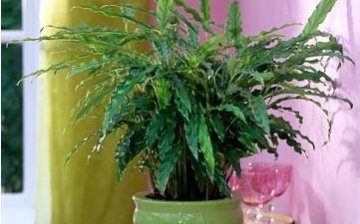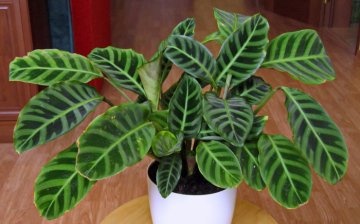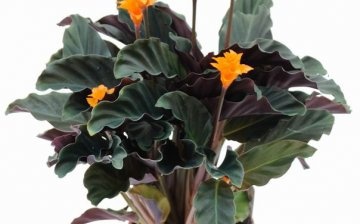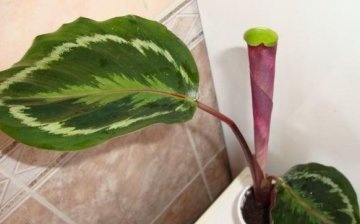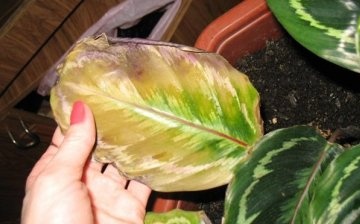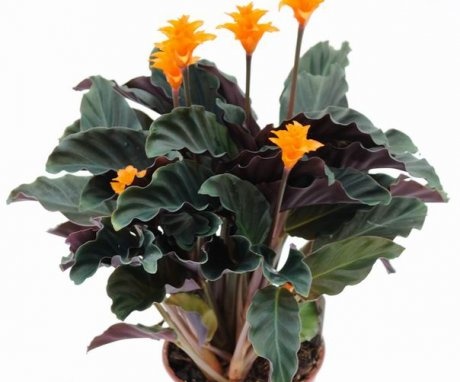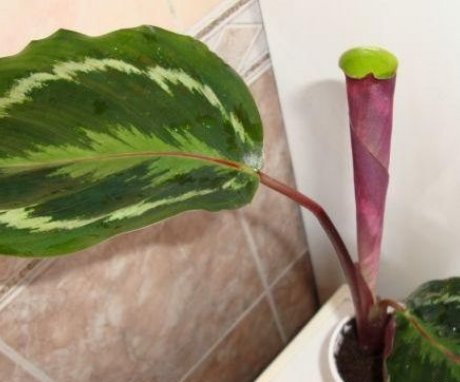Calathea rufibarfa - green beauty on your windowsill
From decorative deciduous houseplants stands out calathea... This is a dense bush with beautifully shaped leaves and with an unusual pattern and colors on them. With proper care, an evergreen plant will delight owners all year round.
Content:
Structural features
Calathea is herbaceous bush, which belongs to the arrowroot family. The homeland of this plant is the forests of Central and South America. The name Calathea is translated from Greek as a basket. This is due to the fact that baskets were woven from the leaves of some species of calathea. Calathea does not have a stem; large leaves of an oval or oval-oblong shape are located on high petioles.
Plant height can reach 85-90 cm.
The color of the leaves depends on the variety of calathea, and the patterns and patterns on the leaf plate may also be different. The root system consists of a large number of small roots.
The peculiarity of this variety is that:
- The petioles of the plant and the lower part of the leaf are covered with a small fluff colored red. The bush is medium in size, dense with proper care.
- Oblong oval leaves, wavy at the edges, located on high petioles.
- The upper part of the leaf plate has a pattern that consists of light green and dark green. The lower part is painted in burgundy-purple tone.
- Leaves in the daytime are arranged horizontally, at night they rise and fold to each other like palms.
Care
Calathea rufibarba is one of those plants that thrive and grow in partial shade. Direct sunlight and intense lighting adversely affect the plant, burns may appear on the leaves and their edges begin to dry out. For placing a pot with a plant, western or eastern windows are perfect. Also, calathea can grow under artificial lighting, provided that the supply of light is 16 hours per day.
For calathea, the acceptable temperature regime is in the range of 20-22 degrees Celsius.
But in the summer, she feels fine at 30 degrees of heat, while intensive humidification of the air in the room is recommended. In winter, in the room where the plant is located, the air temperature should not drop below 18 degrees. If the tubers are supercooled for a long time, the plant will die. Calathea does not tolerate sudden changes in temperature and a change in a permanent place of growth.
Watering the plant:
- In the summer, the calathea is watered regularly, it is not recommended to overflow and waterlogging the soil, since the roots quickly rot and the plant dies. But you can't overdry calathea either.
- To select the optimal watering time, it is recommended to monitor the soil when it dries out by 1-2 cm - you can do the next watering... For this, it is recommended to use soft water at room temperature, settled for 1-2 days.
- In winter, when the plant is at rest, it is recommended to carry out watering 2 days after the topsoil has dried.
Since calathea rufibarba is a tropical plant, it is susceptible to humidity.It is recommended to install a humidifier in the room where the plant is located or to sprinkle the area around the plant with a finely dispersed spray bottle with settled soft water at room temperature every day. Calathea of this variety does not tolerate the ingress of water on the leaves. During the heating season, the pot with the plant can be placed on a pallet with expanded clay or wet sand with water. Periodically, water is poured into the pan.
Every year in the spring and in the first part of summer, it is necessary to make fertilizers into the soil.
For this, a complex feeding for decorative deciduous plants. Such an event is held once every 2 weeks. Calathea does not tolerate an excess of nutrients, it can lose the bright color of the leaves or get sick. Therefore, the dosage and frequency of fertilization are strictly according to the rules.
Calathea does not need pruning... It is periodically necessary to remove old and withering leaves to preserve the decorative effect of the plant.
Transfer
Calathea rufibarba grows well with proper care. The young plant is transplanted annually in the spring, and each time the size of the pot is slightly increased. Adult bushes are transferred to new pots once every 2 years.
A transplant substrate can be bought in stores, a special one designed for planting arrowroot.
You can also make it yourself by mixing peat, calcined river sand, turf soil and the soil of conifers in equal parts. The substrate should be loose and breathable. You can also add some charcoal. A thick layer of drainage must be laid out at the bottom of the pot.
Reproduction
Reproduction of calathea rufibarb can be carried out using dividing the bush or by seed method. The division of the bush is carried out during the spring transplant. For this:
- During the day, the bush is well watered so that the root system can easily come out of the pot. For this method of reproduction, only adult bushes are suitable that have managed to grow a powerful root system or tubers.
- One calathea can be divided into 3-5 new bushes.
- The division is done carefully so that the damage to the roots is minimal.
- At the same time, the entire plant is visible for rotten or dried parts, which are removed with sharp scissors or a knife.
- Each new plant should have at least 3-4 healthy leaves.
- Plants are planted in a fresh substrate, it is recommended to pre-add most of the peat to it.
- After planting, the soil is watered with warm heated water and left to dry. After that, watering is carried out according to the usual system.
- Pots with young bushes are placed in a warm place.
- When new leaves are visible on the calathea, this is a sign that it has taken root and can be transferred into a pot with the usual substrate for arrowroot.
- The transshipment is carried out carefully so as not to damage the root system and are planted in a pot along with an earthen lump.
Propagate calathea with seed longer process. To do this, you must first prepare a substrate, which consists of equal parts of peat and river sand. Peat can be replaced with leafy soil. Neatly laid out in a container with substrates the seeds, on top you need to make a greenhouse.
The temperature in the room where the seedlings germinate should be in the range of 22-25 degrees Celsius.
Crops are periodically moistened with a spray bottle. They are also placed in shade from the sun, but not in the shade. The first pick carried out when 2 adult leaves appear on the sprouts. They are transferred in small groups to containers with the same soil. Care and watering continues in the same mode. When seedling grows up, it is dived into separate small pots for further cultivation.
The seed propagation method is not popular among amateur gardeners, it is mainly used in botanical gardens and greenhouses. Often purchased seeds do not have the promised germination rate, and the percentage of seed hatching.
Diseases and pests
Pests can strike a flower during a period when its health is weakened. For example, spider mites often appear on plants that are placed indoors with dry air. This pest multiplies intensively and settles on the underside of the leaf. It can be seen by the small yellow dots on the plate.
To get rid of the spider mite, it is recommended to remove the affected leaves, and wash the entire bush in soapy water 2-3 times with an interval of 3-5 days.
Diseases in calathea rufibarb can occur with improper plant care:
- The edges of the leaves dry out with dry air and a lack of moisture. Therefore, it is necessary to put a humidifier or regularly spray the leaves of the plant with a spray bottle. This problem is especially important during the heating season.
- If the leaves begin to curl up and the plant's growth has slowed down significantly, this is a sign that the plant is lacking in water and nutrients. Systemic irrigation and feeding complex fertilizers will solve this problem.
- In a cool room, watering should be reduced. With an excess of moisture, the stems and leaves of the calathea will begin to rot, and after a while the entire bush.
- When rot appears, all plants are transplanted into a new pot with fresh substrate and drainage. At the same time, the root system is completely cleaned of old soil and checked for rot, damaged areas are removed.
Calathea loves partial shade, so it is often used to decorate rooms. With proper care, the plant will grow and form a lush and dense bush. A large number of varieties and colors of leaves will not leave indifferent any grower. Plants of different varieties and colors are often planted in one pot to obtain a decorative composition.
More information can be found in the video.



